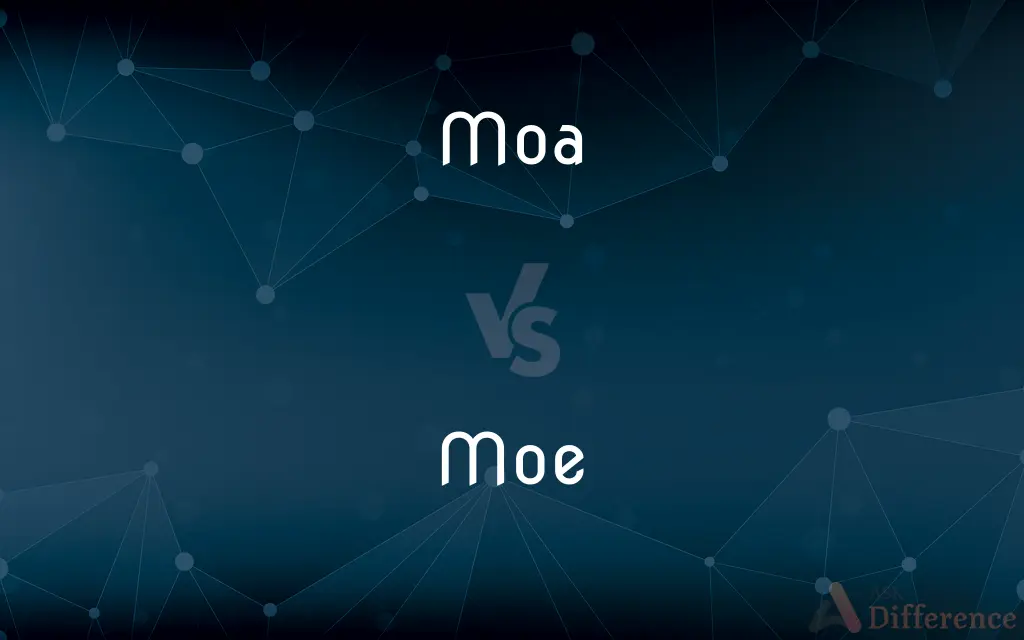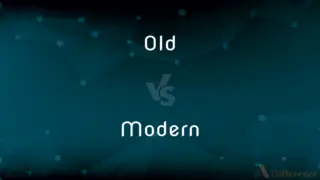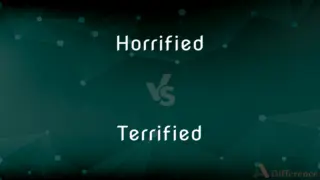Moa vs. Moe — What's the Difference?
By Maham Liaqat & Urooj Arif — Updated on March 27, 2024
Moa were large, extinct flightless birds native to New Zealand, while moe is a term from Japanese culture referring to a feeling of strong affection towards characters in anime or manga.

Difference Between Moa and Moe
Table of Contents
ADVERTISEMENT
Key Differences
Moa refers to a group of extinct flightless birds that were endemic to New Zealand, known for their large size and the absence of wings, even in vestigial form. These birds played a significant role in the ecosystem until their extinction, likely due to overhunting by humans and habitat destruction. On the other hand, moe is a term originating from Japanese otaku culture, describing a feeling of strong affection, protectiveness, and sometimes idealization of characters in anime, manga, or video games, particularly those that are cute or innocent in appearance.
While "moa" denotes a specific biological category, contributing to our understanding of prehistoric life and the impacts of human activity on megafauna, "moe" represents a cultural phenomenon that reflects contemporary interests and aesthetic preferences in Japanese media. Moa were tangible, living creatures that existed within a specific historical and geographical context, contributing to the biodiversity and ecological balance of their environment. Conversely, moe is an abstract concept, reflecting emotional responses and engagement with fictional characters.
The concept of moa is relevant in fields such as paleontology, ecology, and conservation biology, offering insights into the life and extinction of species, as well as the broader dynamics of human interaction with the environment. Moe, however, plays a significant role in the fields of pop culture, psychology, and media studies, highlighting aspects of fan culture, character design, and the emotional connections that audiences form with media content.
In comparing moa to moe, one contrasts the physical and historical reality of extinct animals with the emotional and psychological engagement elicited by fictional characters. This juxtaposition highlights the diverse ways in which terms can reflect very different spheres of human interest and knowledge, from the scientific study of the natural world to the exploration of human emotions and cultural expressions.
Despite their vastly different contexts, both moa and moe carry significance within their respective domains. The study of moa contributes to our understanding of natural history and the consequences of human actions on other species, while the concept of moe offers insights into contemporary cultural trends and the complex ways in which humans interact with media and fiction.
ADVERTISEMENT
Comparison Chart
Definition
Extinct flightless birds native to New Zealand
Feeling of affection towards anime or manga characters
Context
Paleontology, ecology
Japanese otaku culture, media studies
Significance
Historical and ecological importance
Cultural and emotional engagement
Nature
Biological species
Abstract concept
Relevance
Studies of extinction, biodiversity
Fan culture, character design
Compare with Definitions
Moa
Moa were prehistoric flightless birds.
The moa's size varied across species, some reaching over 3 meters tall.
Moe
Evokes protectiveness and admiration.
Fans may feel a strong emotional connection to moe characters.
Moa
Became extinct due to human activities.
Moa were hunted to extinction shortly after humans arrived in New Zealand.
Moe
Refers to a feeling of affection towards characters.
Moe characters often embody youth and innocence.
Moa
Played a key role in their ecosystem.
As herbivores, moa had significant impacts on the vegetation of New Zealand.
Moe
Significant in anime and manga fandom.
Moe elements are strategically used to attract viewers.
Moa
Subject of paleontological study.
Moa bones offer valuable insights into New Zealand's natural history.
Moe
Influences the creation of characters.
Moe characters are designed to be endearing and appealing.
Moa
Their extinction teaches about biodiversity loss.
The loss of the moa is a stark reminder of the impact of human expansion on species.
Moe
Plays a role in fan activities and merchandise.
Moe characters are popular subjects for fan art and collectibles.
Moa
Moa were nine species (in six genera) of now-extinct flightless birds endemic to New Zealand. The two largest species, Dinornis robustus and Dinornis novaezelandiae, reached about 3.6 m (12 ft) in height with neck outstretched, and weighed about 230 kg (510 lb) while the smallest, the bush moa, was around the size of a turkey.
Moe
(slang) Strong interest in, and especially fetishistic attraction towards, fictional characters in anime, manga, video games, and/or similar media.
Moa
Any of various flightless ostrichlike birds of the family Dinornithidae that were native to New Zealand and became extinct, probably before 1500.
Moe
Obsolete form of mow
Moa
Any of several species of large, extinct, flightless birds of the family Dinornithidae that were native to New Zealand; until its extinction, one species was the largest bird in the world.
Moe
Obsolete form of moa
Moa
An extremely tall individual.
Moe
Obsolete form of mo
Moa
Any one of several very large extinct species of wingless birds belonging to Dinornis, and other related genera, of the suborder Dinornithes, found in New Zealand. They are allied to the apteryx and the ostrich. They were probably exterminated by the natives before New Zealand was discovered by Europeans. Some species were much larger than the ostrich.
Moe
Obsolete form of more
Moa
Extinct flightless bird of New Zealand
Moe
Obsolete form of moo
Moe
Obsolete form of mow
Moe
A wry face or mouth; a mow.
Moe
To make faces; to mow.
Moe
More. See Mo.
Common Curiosities
What lessons do we learn from the extinction of moa?
The extinction of moa highlights the vulnerability of isolated ecosystems to human activities, offering lessons on conservation and species protection.
What is the historical significance of moa?
Moa are significant for understanding prehistoric ecosystems and the effects of human settlement and hunting practices on large animals.
Are there efforts to revive extinct species like moa?
While there is interest in de-extinction science, practical efforts to revive species like moa face significant ethical, technical, and ecological challenges.
What impact did moa have on the New Zealand ecosystem?
As large herbivores, moa played a crucial role in shaping vegetation and influencing the ecological balance of their habitats.
How does moe affect anime and manga?
Moe influences character design and storytelling, aiming to create an emotional bond between the audience and the characters.
Why is moe important in Japanese culture?
Moe is a key aspect of otaku culture, reflecting changing tastes and engagement with fictional media.
How do fans express their feelings of moe?
Fans express moe through fan art, cosplay, collecting merchandise, and participating in fan communities.
Can moa be found outside of New Zealand?
Moa were endemic to New Zealand and have not been found elsewhere.
How is moe perceived outside of Japan?
Moe has a global fanbase, with international audiences engaging with and contributing to the culture through various forms of media and fan activities.
What distinguishes moe characters from other anime or manga characters?
Moe characters are specifically designed to evoke a protective and affectionate response, often through their appearance, personality, and vulnerabilities.
Share Your Discovery

Previous Comparison
Old vs. Modern
Next Comparison
Horrified vs. TerrifiedAuthor Spotlight
Written by
Maham LiaqatCo-written by
Urooj ArifUrooj is a skilled content writer at Ask Difference, known for her exceptional ability to simplify complex topics into engaging and informative content. With a passion for research and a flair for clear, concise writing, she consistently delivers articles that resonate with our diverse audience.
















































